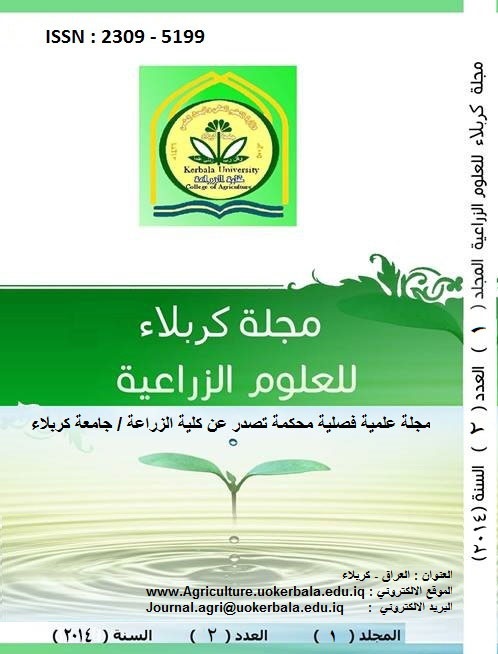The influence of abscisic acid and the physical status of media on the production and qualitative characters of microtubers produced from two potato cultivars grown by in vitro culture.
DOI:
https://doi.org/10.59658/jkas.v1i2.348Keywords:
microtubers, Solanum tuberosum, abscisic acid, media physical statusAbstract
This experiment was conducted in the tissue culture laboratory, Horticulture Department, Agriculture College, University of Baghdad, to investigate the influences of abscsic acid (ABA) and the physical status of growing media for two potato cultivars on the production and qualitative characters of microtubers. Different ABA concentration of 0.0 , 50 , 100 , 150 and 200 mg .l-1 was added to the two growing media the first one was liquid ( without agar ) while the other type the semi-solid media ( 7g.l-1 agar ) for two potato cultivars , Desiree and Revira . Adding ABA at the rate of 0.5 mg . l-1 significantly increased the number, weight , diameter of the microtubers in addition the reducing sugar content and the percentage of protein , while adding 0.25 mg.l-1ABA significantly increased the percentage of starch and this percentage was decresed by increasing the ABA concentration . The liquid growing media was significantly superior in the quantitative and qualitative microtubers characters as compared with semi-solid grown media especially when 0.5 mg.l-1 ABA was used. The Revira cultivar was superior then Desiree in this studied characters except the percentage of starch which was not influenced by the cultivar or the physical status of the growing. The percentage of starch was increased in Desiree cultivar when 0.25 mg.l-1 ABA was added.
Downloads
Published
How to Cite
Issue
Section
License
Copyright (c) 2014 Journal of Kerbala for Agricultural Sciences

This work is licensed under a Creative Commons Attribution 4.0 International License.
Licensing Terms
All articles are published under a Creative Commons License and will be directed to the Creative Commons Attribution 4.0 International License That permits use, distribution, and reproduction in any medium, provided the original work is properly cited and is not used for commercial purposes.
Use by non-commercial users
For non-commercial and non-promotional purposes individual users may access, download, copy, display, and redistribute the articles to colleagues, as well as adapt, translate, text- and data-mine the content subject to the following conditions:
- The author's moral rights are not compromised. These rights include the right of "paternity" (also known as "attribution" - the right for the author to be identified as such) and "integrity" (the right for the author not to have the work altered in such a way that the author's reputation, or integrity may be impugned).
- Where content in the article is identified as belonging to a third party, it is the obligation of the user to ensure that any reuse complies with the copyright policies of the owner of that content.
- If article content is copied, downloaded, or otherwise reused for non-commercial research and education purposes, a link to the appropriate bibliographic citation (authors, journal, article title, volume, issue, page numbers, DOI, and the link to the definitive published version on JKAS website) should be maintained.
- Copyright notices and disclaimers must not be deleted.
- Any translations, for which a prior translation agreement with JKAS has not been agreed, must prominently display the statement: "This is an unofficial translation of an article that appeared in an FSP publication. The publisher has not endorsed this translation."
Use by commercial "for-profit" organizations
Use of JKAS Open Access articles for commercial, promotional, or marketing purposes requires further explicit permission from JKAS (journal.agri@uokerbala.edu.iq) and will be subject to a fee.
The commercial purposes include:
Copying or downloading of articles, or linking to such articles for further redistribution, sale, or licensing; Copying, downloading, or posting by a site or service that incorporates advertising with such content; The inclusion, or incorporation of article content in other works, or services (other than normal quotations with an appropriate citation) that is then available for sale or licensing, for a fee (for example, a compilation produced for marketing purposes, inclusion in a sales pack); Use of article content (other than normal quotations with appropriate citation) by for-profit organizations for promotional purposes; Linking to article content in e-mails redistributed for promotional, marketing or educational purposes; Use for the purposes of monetary reward by means of sale, resale, license, loan, transfer or other form of commercial exploitation such as marketing products; Print reprints of articles can be purchased from journal.agri@uokerbala.edu.iq.
Permissions
- No special permission is required to reuse all, or part of the article published by JKAS, including figures and tables for non-commercial purposes.
- Any part of the article may be reused, for non-commercial purposes, without permission provided that the original article is cited.
- Reuse of an article does not imply endorsement by the authors, JKAS

